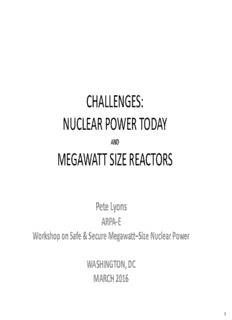Table Of ContentCHALLENGES:
NUCLEAR POWER TODAY
AND
MEGAWATT SIZE REACTORS
Pete Lyons
ARPA-E
Workshop on Safe & Secure Megawatt–Size Nuclear Power
WASHINGTON, DC
MARCH 2016
1
Challenges and Changes to U.S. Nuclear Fleet
“Nuclear plants are under increasing economic pressure to close as a result of
record low capacity prices………… Losing these plants has long-term implications
both to the reliability of the system and on the nation’s emission profile.“
Federal Energy Regulatory Commissioner Moeller, April 2015
• Current stresses on nuclear plants
– Flat or even decreasing electricity demand
– Very low natural gas prices
– Renewable mandates
– Renewable production tax credits
• Market failures have led to plant closings.
– Vermont Yankee shut down December 2014
• Fifth reactor to shut down recently.
– Fitzpatrick, Pilgrim, Oyster Creek slated to close
– Many other plants in difficult financial straits
• Nuclear will be essential in a low carbon future, but will we have the national capabilities when
we need them?
• Discussions continue on how to value the benefits of nuclear energy in today’s electricity
markets.
2
Pathways to a strong future for Nuclear Power
• Passive Safety
• Small Modular Reactors (SMR)
• Integration of renewable and nuclear power
• National path forward on nuclear waste+
• Fukushima and nuclear safety+
• Advanced reactors (covered by previous speakers)
+Not discussed in this talk
3
PASSIVE SAFETY
• ACTIVE SAFETY
- All LWRS in the world today utilize active safety
- Reactors require prompt operator actions in an upset condition
Correct actions typically needed in less than an hour
Frequent Drills with NRC in U.S. to assure operator readiness to respond
Station blackout is particularly challenging event; special precautions in U.S.
Fukushima was seriously compromised by failure to exercise prompt actions.
• PASSIVE SAFETY
- Designed to avoid the need for prompt operator actions
- Typically large quantities of stored coolant moved by gravity or convection
- Some advanced reactors have inherent safety, no meltdown possible.
- Passive safety can extend time for actions from hours to indefinite
- Westinghouse AP1000 was first passively safe reactor certified
No operator actions needed for 3 days.
4
Why are SMR technologies of interest to DOE?
Working definition of SMRs: reactor units with a nominal output of 300 MWe or less and
ability to have large components or modules fabricated remotely and transported to the
site for assembly of components and operation.
Safety Benefits
Passive decay heat removal by natural circulation
Smaller source term inventory
Simplified design eliminates/mitigates several postulated accidents
Below grade reactor siting
Potential for reduction in Emergency Planning Zone
Economic Benefits
Reduced financial risk
Flexibility to add units
Right size for replacement of old coal plants
Use domestic forgings and manufacturing
Job creation
5
U.S. Small Modular Reactor (SMR) Licensing
Technical Support Program
In 2012, DOE initiated a 6-year/$452M program to provide financial assistance for design
engineering, testing, certification and licensing of promising SMR technologies with high
likelihood of being deployed at domestic sites in the mid-2020’s.
Commercial SMR development is being accelerated through public/private arrangements
with 50% cost share provided by U.S. industry partners.
NuScale will file their Design Certification Application with the NRC in 2016
NuScale has filed 10s of topical reports with the NRC
Site permitting and licensing activities are in progress:
U.S. Government Interagency Agreement with TVA to
develop Early Site Permit for Clinch River Site,
to be submitted May 2016, action expected 2019
Cooperative Agreement with NuScale to explore siting SMR at INL
- Site Use agreement for INL signed between DOE and UAMPS – Feb 2016.
6
Key Regulatory Challenges for SMRs
• Refinement of the Emergency Planning Zone
• Appropriate size of the control room staff
• Appropriate size of the security staff
7
Integration of Renewable and Nuclear Power
Leaders: NREL, INL, and MIT
• Hybrid Energy Systems
– Focus on recognition that only Renewables, Nuclear and Hydro
are clean energy sources available today.
– Hydro can not expand significantly in the U.S.
– Emphasize integration of assets on a grid level
– Recognize that a national grid must exhibit supply diversity and
high levels of reliability
• Key Attribute
– Designed to optimize contribution of both nuclear and
renewable assets
– Cleanly produce all needed electricity PLUS another asset in the
industrial or transportation sector
8
Schematic of a Hybrid System
9
Potential Applications of Megawatt
reactors
• Remote locations
– Replace diesel generators
• Distributed generation
– Address DOE mission to significantly reduce
carbon emissions if deployed in large numbers
• Military applications
– Appropriate only if funded by DoD, not ARPA-E
10
Description:1 CHALLENGES: NUCLEAR POWER TODAY AND MEGAWATT SIZE REACTORS Pete Lyons ARPA-E . Workshop on Safe & Secure Megawatt– Size Nuclear Power. WASHINGTON, DC

